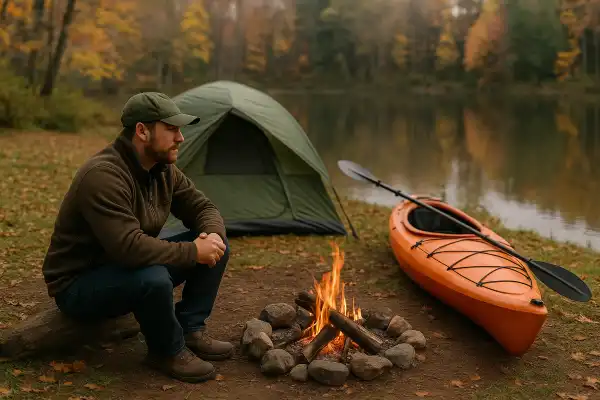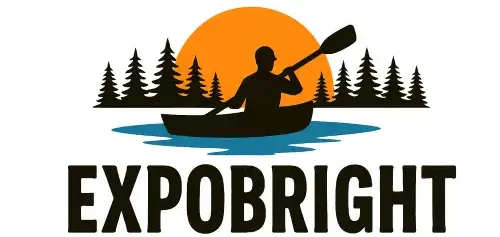Where can you kayak camp in Wisconsin? This question echoes through countless online forums and outdoor gear shops across the Midwest, and for good reason. Wisconsin’s remarkable landscape of lakes, rivers, and Great Lakes shoreline creates a paddler’s paradise that rivals destinations anywhere in North America.
Last spring, I guided a family from Chicago on their first multiday kayak camping trip, watching their amazement as we paddled through morning mist rising off the Turtle-Flambeau Flowage. Their youngest daughter, barely ten, had worried she wouldn’t be strong enough for the journey, but by our second evening around the campfire on a secluded island, she was already planning next year’s adventure.
Where can you kayak camp in Wisconsin?
Wisconsin offers outstanding kayak camping opportunities ranging from beginner-friendly river sandbars to challenging Great Lakes island expeditions. The state provides diverse options including designated river and lakeside sites within State and National Parks, remote wilderness camping on public lands, and specialized water-only campsites accessible exclusively by paddle craft.

Apostle Islands National Lakeshore: The crown jewel
The Apostle Islands National Lakeshore offers campsites on 18 of the 21 islands, plus mainland sites accessible only by kayak or hiking. This Lake Superior gem demands advanced sea kayaking skills and proper planning, but rewards paddlers with bucket-list experiences including sandstone caves, cliffs, rock shelves and arches set against an inland sea of jade green water.
All island campsites require advance reservations through Recreation.gov, with permits covering up to 14 consecutive nights. Within the National Lakeshore, you’ll find individual sites for seven or fewer people, group sites for eight or more, and primitive zone camping for five or fewer with no amenities.
Popular islands for first-time visitors include Sand Island, offering historic lighthouse access and sea caves at Swallow Point, and York Island with north-facing beaches that feel genuinely remote. Stockton Island boasts Julian Bay’s singing sands and multiple campsites between Quarry Bay and Presque Isle Bay.
Planning considerations: Lake Superior can generate dangerous conditions quickly. This is not a destination for weekend warriors without proper planning, preparation, experience and gear. Consider using professional outfitters for your first Apostle Islands experience.
Wisconsin River: Free camping on shifting sandbars
From Prairie du Sac, the Wisconsin River flows freely for 92 miles to the Mississippi, featuring shifting islands and sandbars open to tent camping without permits or fees. This represents some of the most accessible kayak camping in the state.
The river’s constantly shifting sandbars and shallow five-foot average depth discourage motorboats, creating a kayak-friendly environment. Sandbars are first-come, first-served, with the ideal setup including a small stand of trees at one end for privacy and wind protection.
Water level awareness: During dry weather, river levels remain stable, but heavy rains can raise water levels a foot or more overnight. Set camp at least 16 inches above the waterline and monitor conditions carefully.
Logistics: Bring 1.5 gallons of water per person per day, as river water contains significant sand and tannins that quickly clog filters. The only requirement is arriving and departing by watercraft.
Turtle-Flambeau Flowage: Island camping paradise
The Turtle-Flambeau Scenic Waters Area offers 66 remote campsites accessible only by water, scattered throughout this massive flowage where islands were created when the dam was installed. This nearly 13,000-acre body of water includes double that acreage of undeveloped forest and a vast assortment of islands both large and small.
For the 2025 season, most sites operate first-come, first-served with a 10-day camping limit. Beginning in 2026, all campsites will require reservations and fees. Each designated site includes a steel fire ring and open-air pit toilet.
Booking strategy: Because camping is first-come, first-served through 2025, always have a contingency plan as sites may be unavailable upon arrival. Alternative accommodations include Lake of the Falls County Park on the flowage’s north end.
Chequamegon-Nicolet National Forest: Diverse water access camping
The Chequamegon-Nicolet National Forest covers more than 1.5 million acres across Wisconsin’s Northwoods, managing the land for multiple uses including recreation. Several campgrounds offer modern conveniences while others provide primitive tranquil getaways.
Notable water-access locations include:
Bear Lake Recreation Area: Offers camping, fishing, swimming, kayaking and canoeing opportunities with developed facilities.
Birch Grove Recreation Area: Nestled between 22-acre East and 16-acre West Twin Lakes, serving as an excellent base camp for exploring the Bayfield Peninsula.
Black Lake Recreation Area: Spread along the eastern shores of Black Lake, where calm waters beckon adventurers.
Many forest campgrounds can be reserved through Recreation.gov, though some offer first-come, first-served sites. You can also primitive camp anywhere within national forest boundaries fee-free, following rules including camping at least 100 feet from trails and water bodies.
Northern Highland American Legion State Forest: Canoe route camping
Northern Highland American Legion State Forest manages canoe routes from lake to lake throughout Northeastern Wisconsin with primitive campsites established along shorelines, offering experiences similar to the Boundary Waters with multi-day trip routes and portage trails.
Bittersweet Lakes State Natural Area allows paddling within a designated natural area requiring portages between four lakes – Oberlin, Smith, Bittersweet and Prong. Five reservable, rustic sites accommodate up to six people for one night only.
Additional notable destinations
Kickapoo Valley Reserve: Features rustic campsites along the banks of the winding Kickapoo River, where paddlers fall asleep to owl calls and wake to morning mists rising off the water.
Castle Rock Lake: Wisconsin’s fourth largest lake offers paddle-up sites where a short trail from your tent leads directly to shoreline access.
Various State Parks: Multiple Wisconsin state parks provide water access camping, including Governor Dodge State Park with Cox Hollow Lake and Twin Valley Lake for kayak exploration.
Essential planning considerations
Skill level matching: Great Lakes camping demands advanced skills, while river sandbar camping suits beginners. Choose destinations matching your experience level.
Reservation requirements: Popular destinations like the Apostle Islands require advance booking. Reserve early, especially for summer weekends.
Weather monitoring: Wisconsin’s weather can change rapidly, particularly on the Great Lakes. Always check forecasts and have contingency plans.
Water and waste management: Many sites lack potable water. Plan accordingly and follow Leave No Trace principles.
Transportation logistics: Factor in shuttle services or gear transport when planning multiday trips.
Conclusion
Three months ago, I returned to my favorite sandbar on the Lower Wisconsin River, the same spot where I’d first learned to read water levels and wind patterns fifteen years earlier. Watching the sunset paint the bluffs golden while wood ducks settled into evening roost, I remembered why Wisconsin’s waters captured my heart completely. Following comprehensive planning guidelines transforms uncertain paddlers into confident adventurers ready to create lifelong memories on Wisconsin’s incredible waterways.
